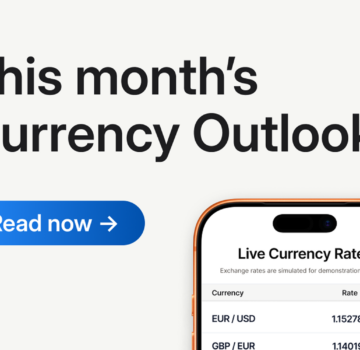Managing business expenses efficiently is critical to a company’s financial health. But many companies still rely on outdated, manual processes that lead to inefficiencies, errors, and even fraud. And as operations expand, these aging processes can slow you down.
Keeping control over company spending becomes a greater challenge the more you scale.
This is where spend management platforms make all the difference. They’re a streamlined, automated, and secure solution to help finance teams stay in control of company spending.
Looking for a better way to control your business spend?
This article explains what spend management platforms actually are and do, and what to prioritise when you look for yours. Then we introduce six of the very best solutions available today, to help you choose.

What is a spend management solution?
A spend management solution is a platform or tool that lets you track, control, and optimise company expenses easily. Spend management includes everything from employee reimbursements, to vendor payments, to corporate card usage.
How does expense management software work?
Compared with pure expense management or invoice processing tools, spend management takes a more holistic approach. Expenses and invoices are key business processes, but most handle these completely separately. Spend management considers these to be two crucial pillars of company spend, along with credit card payments.
It’s all company spending after all, so it makes sense to manage it from the same platform.
And without a cohesive system in place, businesses risk overspending, compliance issues, and a lack of financial visibility.
What are traditional spend management challenges?
For decades, businesses have used spreadsheets, paper receipts, and disconnected systems to track their spending. Others have simply relied on team trust and communication, while very small companies may funnel all payments through the founder or CEO.
This approach has numerous serious issues – challenges that are now addressed by spend management software:
1. Lack of real-time visibility
With no centralised system, finance teams struggle to track expenses across departments. Payments might be made, but the expense claims come through months later. This leaves you with no control over spending as it occurs, and also makes budgeting and forecasting costs incredibly difficult.
2. Human errors from manual data entry
Paper-based and manual processes increase the risk of mistakes. Even copy/pasting between spreadsheets is a worry. Today, with automated expense fraud detection, integration with accounting systems, and receipt management, you’re far better off avoiding data entry altogether, which the tools on our list below make possible.
3. Slow approval workflows
Most employee spending requires some form of approval from a manager. If that approval is given on an ad hoc, manual basis, it creates a bottleneck in the system. Employees either need to wait hours (or sometimes days) to have their costs approved, or they need to interrupt their work (and their manager’s).
Manual approvals also create issues for finance teams. If the approval is missing from an expense, the finance team then needs to interrupt their own work to find out what happened.
The net outcome is that employees wait weeks for reimbursements, and your whole expense reconciliation process takes far longer than it should. In the meantime, employees may exceed budgets with little oversight, and expense policies can go unenforced.
Spend management solves these problems by issuing virtual cards or providing a centralised, automated platform that gives finance teams complete control over business spending. We’ll see this in more detail shortly.
5 key features to look for in top spend management platforms
With a range of options, choosing the right spend management solution for your business can be difficult. As you shop around, look for these five vital features and benefits of spend management software.

- 1. Real-time expense tracking
This is non-negotiable. If a potential spend management solution doesn’t let you track spend in real time, walk away immediately.
Good platforms give businesses real-time visibility into all transactions, ensuring teams can monitor and control company spending instantly. Instead of waiting for end-of-month reports, your finance team can track spend as it happens.
Managers can also keep on top of their budgets as spending occurs, and individual employees can track their subscriptions and other costs.
Nobody should have to wait until the end of the month for spend data anymore.
- 2. Corporate cards with custom controls
In the past, company cards were reserved for the top of the food chain, and occasionally for very busy travelers. But today, you can give every employee a corporate card and trust that they’ll use it wisely, safely, and stick to the rules.
Spend management platforms offer virtual and physical corporate cards with customisable spend limits and automatic expense categorisation. Finance teams can set budgets per department, project, or individual employee, ensuring compliance with company policies.
These cards all but eliminate out-of-pocket expenses — a massive administrative headache gone.
- 3. Automated approvals and reporting
As we saw above, manual approvals slow businesses down. But spend management solutions automate approval workflows, speeding up processing times while ensuring compliance.
Here’s how the process should go:
- An employee requests a new purchase or submits a reimbursement claim.
- Their manager is notified and can either approve in a click, or ask for more information.
- Once approved, the employee can make the purchase, or send their claim to finance (again, in just a click).
- Finance receives a full record of approval and can reimburse the employee, or reconcile the payment instantly.
All of that can take as little as a few seconds. Plus, all expenses are logged and categorised for seamless reporting and reconciliation. There’s a clear audit trail the whole way, and finance teams don’t have to work backwards to figure out who spent what, and why.
- 4. Global payments and FX optimisation
For businesses operating internationally, managing foreign transactions can be costly. Spend management platforms integrate multi-currency accounts and competitive FX rates, to help you reduce currency conversion costs while simplifying international payments.
OFX, for example, lets you hold multiple currency accounts inside one profile. If you need to spend another currency, there’s no need to convert – you spend out of an existing pool and save on fees.
There should never be an issue for employees to spend wherever they need to. With the right spend management platform, there won’t be.
- 5. Integrations with accounting tools
Whether it’s Xero, QuickBooks, or an ERP like NetSuite, accountants live inside cloud accounting platforms. So to reconcile costs and close the books, it’s vital that your spend management solution communicates smoothly with that accounting tool.
Thankfully, most spend management platforms connect with popular accounting tools, reducing the need for manual data entry and ensuring accurate financial reporting. If they don’t, they should make exporting data easy and fast–no more than a few clicks.
Make sure you ask about integrations as you consider your spend management options.
6 best spend management solutions for SMEs
There’s a wide range of systems available that solve at least some of the key spending challenges we’ve seen. These tools can also be targeted solutions for different business types (e.g. small businesses, medium-sized businesses). Regardless, below are some of your best options to overcome most — if not all — at once.

- 1. OFX – Best for international payments & multi-currency expense management
OFX’s spend and payments management platform streamlines business payments, invoices, expense tracking, and multi-currency transactions. Unlike other tools, OFX is an all-in-one solution that integrates foreign exchange (FX) management, making it great for businesses that operate internationally and want to minimise FX costs while controlling expenses.
Whether it’s paying suppliers, managing payroll, or issuing corporate cards, the platform simplifies every step of the spend management process. It helps streamline financial workflows, improve efficiency, and strengthen security, giving you enhanced visibility and control over your financial operations.
When paired with OFX’s industry-leading FX and global transfer capabilities, businesses can confidently manage spending worldwide — while accountants get seamless oversight and easy transaction management.
Who it’s for: Small-to-medium businesses with global operations, frequent international transactions, or those needing seamless FX integration.
Pros:
- Multi-currency support for businesses paying international suppliers or staff
- Competitive FX rates and lower margins than banks
- Virtual and physical employee corporate cards for seamless business spending
- Automated reporting and real-time tracking for complete visibility
Cons:
- Ideal for international businesses; those with only domestic expenses may not need all features
- Not yet as widely adopted as some competitors in the UK
- 2. Pleo – Best for smaller businesses with lots of on-the-go expenses
Best known for its easy-to-use employee corporate cards, Danish solution Pleo has been improving company spend processes since 2015. It offers an intuitive expense management solution with smart company cards, real-time tracking, and automated receipt capture1.
Designed for small to mid-sized businesses, it simplifies spending by reducing manual reimbursement processes. Accountants and finance teams love the fact that, if every employee has a Pleo card, there’s no need for expense claims. And its receipt capture tool (“Fetch”) even retrieves receipts from email inboxes, removing one extra administrative hurdle2.
Who it’s for: SMEs and fast-growing businesses looking for automation and real-time expense tracking.
Pros:
- Virtual & physical cards with spending controls
- Automated receipt capture & categorisation
- Integrates with major accounting software (Xero, QuickBooks, Sage)
Cons:
- Relatively light invoice processing and accounts payable tools
- May not be suitable for large enterprises with complex approval workflows
- 3. Soldo – Best for companies wanting all the spend management classics
Soldo provides prepaid cards for employees and teams, offering businesses real-time spend tracking, automated reporting, and multi-currency support. It’s particularly useful for companies managing distributed teams or remote employees.
Soldo offers all the key features you’d expect from a spend management platform: prepaid company cards with custom controls, expense claim automation, receipt capture tools, real-time visibility over spending, multi-entity support, and seamless integrations with Xero, QuickBooks, and NetSuite3.
Soldo gives you more control, visibility, and less hassle—while helping employees to spend responsibly.
Who it’s for: Businesses needing better control over employee and departmental spending.
Pros:
- Customisable budgets & real-time expense tracking
- Multi-currency wallets for international transactions
- Strong security & compliance features
Cons:
- Limited invoice management features
- Prepaid model means funds need to be topped up in advance
- 4. Brex – Best for growing companies that need banking & spend services
Brex is a corporate financial platform designed for fast-growing companies. It includes all the major spend management features—corporate cards, expense management, travel booking, and bill payments. But it’s also a bank account, offering competitive interest rates and loans — unlike the other solutions on this list4.
It’s built to help startups, scaleups, and enterprise businesses manage their finances with greater speed, flexibility, and control. With an impressive (and growing) list of features, Brex may soon be better described as a financial institution than a spend management solution5.
Pros:
- Supports international payments in USD or local currency transactions
- Integration with various apps such as QuickBooks, NetSuite, and SAP
- Strong AI features, with new capabilities added regularly
Cons:
- Unless you want to bank with Brex, it may be far more than you need
- Most popular in the U.S., and not currently available in the U.K.
- 5. Spendesk — Best for larger SMEs and enterprise companies
Spendesk is an all-in-one expense management platform that combines payment cards, invoice processing, and reimbursement management. It’s ideal for businesses that need greater control over spending while automating approval workflows.
Having started with smart company cards, the Spendesk platform now includes expense management, procurement tools, pre-accounting automation, budgets, and more tools for busy finance teams6.
Who it’s for: Companies looking for a fully integrated spend management solution with approvals & invoices, and a high degree of customisation.
Pros:
- End-to-end spend management (cards, reimbursements, & invoices)
- Custom approval workflows to prevent overspending
- Real-time reporting & spend analytics
Cons:
- Pricier compared to some competitors
- Can be complex for very small businesses with minimal expenses
- 6. Expensify — Best for pure expense automation
Expensify is an expense management platform that automates the process of tracking receipts, submitting expense reports, and reimbursing employees. It started as a tool to simplify individual expense tracking but has grown into a broader platform that includes corporate cards, invoicing, bill pay, and travel booking7.
Expensify’s core strength is in expense automation – capturing receipts, matching them to transactions, and submitting them for approval with minimal manual effort. It’s arguably the best-known solution for this specific challenge on the market, with more than 12 million users8.
Who it’s for: Small businesses, startups, and remote teams needing mobile-friendly expense capture tools.
Pros:
- End-to-end spend management (cards, reimbursements, & invoices)
- Custom approval workflows to prevent overspending
- Real-time reporting & spend analytics
Cons:
- Pricier compared to some competitors
- Can be complex for very small businesses with minimal expenses
How to choose the right spend management software
Choosing the right platform depends on your business size, complexity, and spending needs. It also depends on how detailed your reporting needs to be, and whether you have specific requirements for international transfers and foreign exchange.
Factors to consider when comparing leading software solutions
Comparing software could help you choose which spend management tool is best for your business. After taking a look at the offerings of all the software options mentioned above, consider how the following factors compare:
- Automated or AI-powered categorisation and anomaly detection
- Corporate card limits
- Multi-currency support (e.g. how many foreign currencies can be held)
- Spending tracking and curation
- Integration with accounting platforms that your business uses (e.g. Xero, Quickbooks)
- Price points for monthly plans
- Customer support for software complications (e.g. in-person branches, 24/7 chat help)
All of the tools on our list have their pros and cons. So it’s important to find a solution that speaks your language and understands your core pains. Spend management should be fast and easy, but that relies on the right fit between your business and technology.
Best practices for implementing your spend management software
Don’t forget, once you’ve chosen your spend management software, you’ll also need to integrate it into your business processes to reap its benefits. Keep in mind the following best practices so you get the most out of your spend management tool.
Keep onboarding considerations in mind
Develop an onboarding guide for smooth integration. You can work with the support team of your spend management software to develop demos and teach internal staff members how to make the best use of the tool.
Start with custom approval workflows
Customise your approval workflows based on your business needs and internal staff structure. This is so you can eliminate the headache of manual approvals and start spending as soon as possible.
Communicate the adoption of your spend management software to staff
This may be an obvious step to implementation, but be sure to communicate to all relevant personnel that business expenditure will be tracked by your new spend management software. That way, all team members have accounts and their spending can be tracked on the tool with real-time visibility.
Why choose OFX over traditional spend management tools?
There are a number of platforms that can support businesses as they grow. When deciding on the platform for your business, you will need to take into consideration how quickly your business will grow, users, account packages you’re using and more.
Unlike other spend management tools, OFX’s platform is built with a global-first approach, designed to help businesses manage expenses efficiently while reducing FX costs. With 24/7 human support, a user-friendly interface, and competitive pricing, businesses can take full control of their spending without unnecessary complexity.
If you’re looking for a comprehensive solution that combines expense management, invoices and approvals, payments, and FX in one – explore how OFX’s spend management platform can help streamline your financial operations.
Ready to start on the tools?
Sign up for a free trial to OFX Full Suite, take a virtual tour or contact us today to take control of your business finances.
- https://www.pleo.io/en/features
- https://www.pleo.io/en/fetch
- https://www.soldo.com/en-gb/
- https://www.brex.com/product/cash-management-account/rates-fees
- https://www.brex.com/product/business-account
- https://www.spendesk.com/solutions/
- https://use.expensify.com/all-features
- https://we.are.expensify.com/what-we-do
This article is purely for informational purposes only and should not be treated as advice. OFX will not be held liable for any losses incurred as a result of individuals or businesses relying on the information contained in this article
IMPORTANT: The contents of this blog do not constitute financial advice and are provided for general information purposes only without taking into account the investment objectives, financial situation and particular needs of any particular person. UKForex Limited (trading as “OFX”) and its affiliates make no recommendation as to the merits of any financial strategy or product referred to in the blog. OFX makes no warranty, express or implied, concerning the suitability, completeness, quality or exactness of the information and models provided in this blog.



